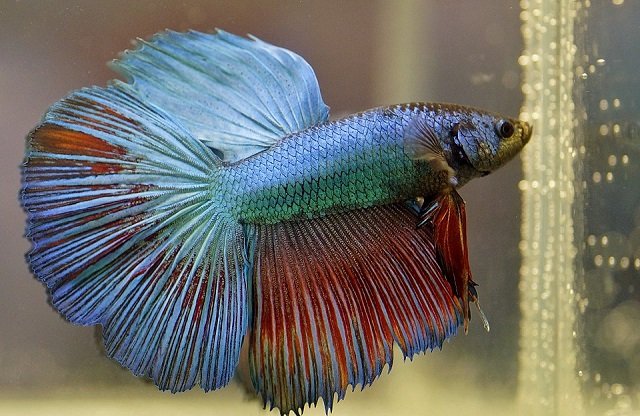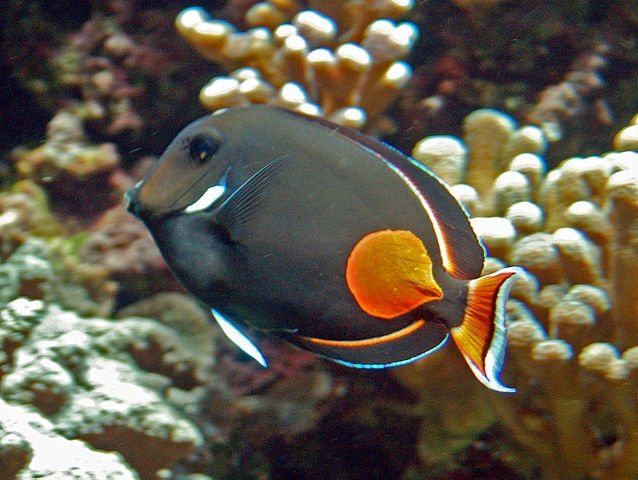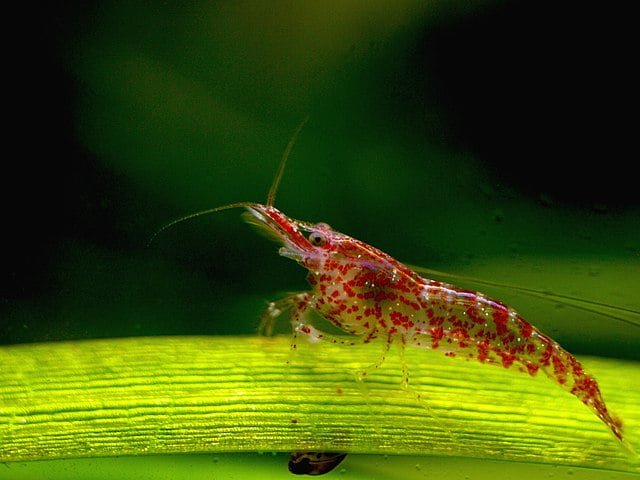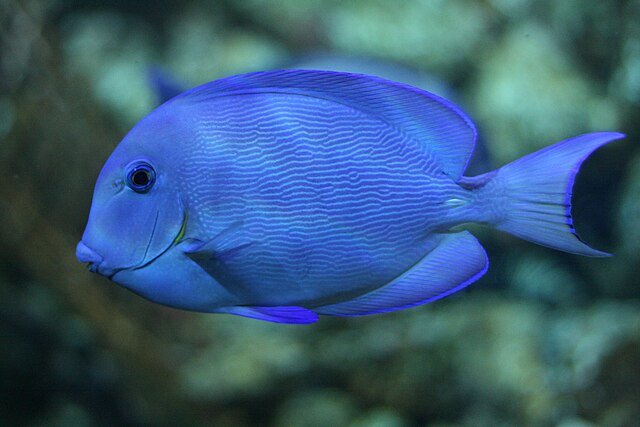
The Atlantic Blue Tang (Acanthurus coeruleus) is a popular marine fish among aquarists due to its striking bright blue coloration and active behavior. Native to the warm waters of the Western Atlantic, this fish is known for its ability to change color depending on its emotional and environmental state. Although it is a relatively hardy species, it requires specific care to thrive in an aquarium.
In this article, we will explore all the essential aspects of keeping this fish healthy and happy in your marine aquarium.
Atlantic Blue Tang Characteristics
- 1 Atlantic Blue Tang Characteristics
- 2 Natural Habitat: Where Does the Atlantic Blue Tang Live?
- 3 Aquarium Care: Essential Requirements
- 4 Feeding the Atlantic Blue Tang: Diet and Suggestions
- 5 Breeding of the Atlantic Blue Tang in Captivity
- 6 Compatibility with Other Species in Aquariums
- 7 Disease Prevention
- 8 Conclusion
- 9 References
- 10 Entradas relacionadas:
Taxonomy
- Domain: Eukaryota
- Kingdom: Animalia
- Phylum: Chordata
- Class: Actinopterygii
- Order: Acanthuriformes
- Family: Acanthuridae
- Genus: Acanthurus
- Species: Acanthurus coeruleus (Bloch & J. G. Schneider, 1801)
- Spanish names: Pez cirujano azul, pez cirujano azul caribeño, barbero, barbero azul, navajón azul, sangrador azul.
- English names: Atlantic blue tang, blue barber, blue doctor, blue doctorfish, blue tang, blue tang surgeonfish, doctor fish, yellow barber, and yellow doctorfish.
Physical Characteristics of the Atlantic Blue Tang
The Atlantic Blue Tang is easily recognizable by its vibrant blue color, which can range from a sky blue in juveniles to a deeper blue in adults. It is important to note that during its juvenile stage, this fish is bright yellow, gradually transitioning to blue as it reaches adulthood.
This fish also features an oval-shaped body and a dorsal fin that extends almost the entire length of its body, contributing to its elegant and streamlined appearance. Acanthurus coeruleus is distinguished from other surgeonfish by the yellow color of its caudal spine.
Color Changes
A fascinating feature of the Atlantic Blue Tang is its ability to change color. These fish can display different shades of blue or even gray when stressed or at night, reflecting their ability to adapt to varying conditions.
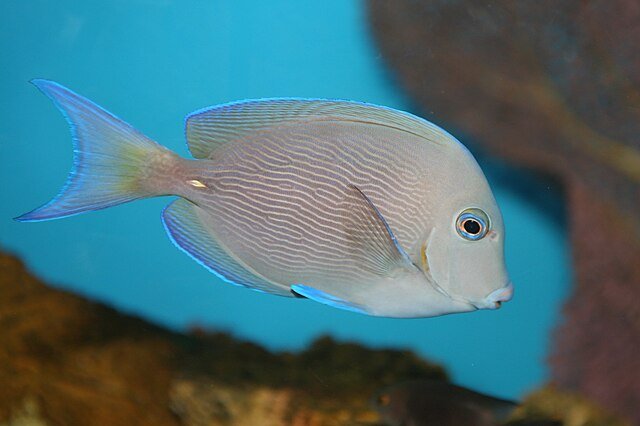
Size and Growth
In the wild, Atlantic Blue Tangs can grow up to 39 cm (15 inches) in length, although in aquariums, they are usually a bit smaller, reaching between 20 and 25 cm (8-10 inches). Their growth is relatively fast, especially when provided with a proper diet and a suitable environment.
Acanthurus coeruleus can live up to 47 years.
Natural Habitat: Where Does the Atlantic Blue Tang Live?
The Atlantic Blue Tang primarily inhabits coral reefs in the Western Atlantic, ranging from Florida and the Gulf of Mexico to Brazil. It prefers warm waters, typically between 24°C and 28°C (75°F and 82°F), and is commonly found in areas rich in coral and sponges.
Stay Always Informed
Join our communities to instantly receive the most important news, reports, and analysis from the aquaculture industry.
Acanthurus coeruleus is typically found at depths of 2 to 18 meters; however, specimens have been observed at depths of up to 60 meters. In its natural habitat, newly settled blue tangs are found on the reef crest and spur-and-groove zones, while larger juveniles are more common on the back reef, and adults are evenly distributed throughout all zones.
Due to the ornamental fish trade, Acanthurus coeruleus has been reported in Cyprus (Langeneck et al., 2012), on the Mediterranean coast of Israel (Golani et al., 2015), and on the island of Malta in the middle of the Mediterranean Sea (Evans et al., 2015). Specimens have also been reported in the Canary Islands (Falcón et al., 2023).
Aquarium Care: Essential Requirements
Caring for the Atlantic Blue Tang (Acanthurus coeruleus) requires attention to several key factors, including water quality, compatibility with other species, and providing an environment that allows them to exhibit natural behaviors.
Tank Requirements
Due to their size and active nature, a tank of at least 300 liters (80 gallons) is recommended for an adult Atlantic Blue Tang. A larger aquarium will not only provide more swimming space but also help dilute waste and maintain water quality.
Water Quality
Water quality is crucial for the health of any marine fish, and the Atlantic Blue Tang is no exception. Maintaining stable pH levels between 8.1 and 8.4 and a salinity of around 1.020-1.025 is essential. Additionally, regular water changes, ideally 10% weekly, are important to prevent the accumulation of nitrates and other toxic substances.
Lighting and Decoration
Lighting should be moderate to high, especially if corals are present in the same aquarium. Rock formations should be solid and provide the fish with places to hide and explore, offering them security and reducing stress.
Feeding the Atlantic Blue Tang: Diet and Suggestions
Proper feeding is crucial for the health and vibrant color of the Atlantic Blue Tang. This fish is herbivorous, meaning its diet should consist primarily of algae and marine vegetables. Tilghman et al., (2001) evaluated the dietary choices of Acanthurus coeruleus in Florida and reported that this fish selected red and green algae; Dell et al., (2020) indicated that the Atlantic Blue Tang consumes approximately 40 grams of the macroalga Dictyota per day, in addition to Lobophora.
Basic Diet
Dried seaweed, such as nori, is an excellent source of nutrition and should be available to the fish at all times. It is also recommended to supplement its diet with spirulina, romaine lettuce leaves, and commercially formulated products for herbivorous fish.
Nutritional Supplements
To ensure the fish receives all necessary vitamins and minerals, adding vitamin supplements to its diet is beneficial. This can include products specifically designed to enhance color and strengthen the fish’s immune system.
Feeding Frequency
The Atlantic Blue Tang is a continuous feeder in the wild, so it is best to offer several small meals throughout the day rather than one large meal. This also helps prevent health issues related to overfeeding, such as fatty liver accumulation.
Breeding of the Atlantic Blue Tang in Captivity
Breeding the Atlantic Blue Tang in captivity is a challenge and is rarely successful in home aquariums. However, with the right conditions, it is possible to observe their reproductive behavior. Fish of the genus Acanthurus do not exhibit sexual dimorphism and reach sexual maturity at approximately 14 cm, at around 3.2 years of age (Sátyro y Teixeira, 2008).
Reproductive Behavior
In the wild, Atlantic Blue Tangs breed in groups, with females releasing pelagic eggs that are fertilized by males. Colin y Clavijo (1988) report that Acanthurus coeruleus exhibits a clear lunar periodicity in group spawning; however, this fish also spawns in pairs.
The research by Vilanova et al., (2018) confirms evidence of multiple spawning events, with batch fecundity ranging from 20,000 to 55,000 oocytes. They report that the species spawns once every 3.8 days, during a 6-month spawning season that lasts from August to January in Brazil.
The eggs float and hatch after approximately 24 hours, releasing larvae that become part of the marine plankton for 46 to 57 days until they are large enough (26.7 mm) to settle on the bottom and develop their blue coloration.
Breeding Attempts in Aquariums
In captivity, replicating these conditions is extremely difficult. The most experienced aquarists may attempt to encourage breeding by adjusting temperature and feeding, but the chances of success remain low. Generally, Atlantic Blue Tangs in aquariums are either wild-caught or bred in specialized facilities.
Compatibility with Other Species in Aquariums
Juvenile Atlantic Blue Tangs (Acanthurus coeruleus) are solitary and territorial; however, adult fish tend to form schools. It has been reported that adult A. coeruleus are consistently territorial or non-territorial, with territorial individuals found in schools and wandering. Additionally, territorial adults engage in aggressive interactions with their conspecifics and congeners.
It is important to consider their compatibility with other fish species when planning an aquarium.
Tank Mates
The Atlantic Blue Tang (Acanthurus coeruleus) can coexist with other species of tangs, as long as the tank is large enough to avoid territorial conflicts. It is also compatible with many other reef fish species, such as clownfish, gobies, and damselfish. However, it is advisable to avoid aggressive fish that may harass the Tang.
Territorial Issues
In confined spaces, Atlantic Blue Tangs can become aggressive towards other fish of the same species or with similar shapes and colors. Providing hiding places and visually dividing the tank with rocks can help mitigate these behaviors.
Disease Prevention
The Atlantic Blue Tang is susceptible to diseases such as white spot disease (Ich) and lateral line erosion (LLE). To prevent these conditions, it is vital to minimize stress, offer a balanced diet, and avoid sudden changes in water quality. In case of illness, early treatment in a quarantine tank can save the fish’s life.
White Spot Disease (Ich)
White spot disease is one of the most common diseases in Atlantic Blue Tangs. This disease, caused by a parasite, appears as small white spots on the fish’s skin. Treatment includes raising the water temperature and applying specific medications.
Lateral Line Erosion (LLE)
Lateral line erosion is another common disease, generally caused by nutritional deficiencies and suboptimal water conditions. Ensuring the fish’s diet is rich in vitamins and maintaining clean water can prevent this condition.
Stress and Its Impact on Health
Stress is an underlying factor in many fish diseases. Maintaining a calm environment, with compatible tank mates and proper aquarium management, is crucial to reducing stress and keeping your Atlantic Blue Tang in the best condition.
Conclusion
The Atlantic Blue Tang is a wonderful choice for aquarists with experience in marine fish care who can provide a suitable environment for this species. Its stunning color and active behavior can be a visual spectacle in any aquarium, but they also require a commitment in terms of space, maintenance, and attention. If you can meet their needs, the Atlantic Blue Tang will be a vibrant and healthy addition to your marine community.
References
Colin, P. L., & Clavijo, I. E. (1988). Spawning activity of fishes producing pelagic eggs on a shelf edge coral reef, southwestern Puerto Rico. Bulletin of Marine Science, 43(2), 249-279.
Dell, C. L., Longo, G. O., Burkepile, D. E., & Manfrino, C. (2020). Few Herbivore Species Consume Dominant Macroalgae on a Caribbean Coral Reef. Frontiers in Marine Science, 7, 506934. https://doi.org/10.3389/fmars.2020.00676
Evans, J., Tonna, R., & Schembri, P. J. (2015). Portent or accident? Two new records of thermophilic fish from the central Mediterranean. BioInvasions Record, 4(4), 299-304. DOI: http://dx.doi.org/10.3391/bir.2015.4.4.12
Falcón, J.M., Brito, A., Herrera, R., Ayza, O., Moro, L. y Caro, M.B., 2023. Peces marinos tropicales exóticos de Canarias. Consejería de Transición Ecológica, Lucha contra el Cambio Climático y Planificación Territorial del Gobierno de Canarias. 247 pp.
Golani D., Askarov G., Appelbaum-Golani B. 2015. First confi rmed record of the blue tang, Acanthurus coeruleus (Actinopterygii: Perciformes: Acanthuridae) in the Mediterranean. Acta Ichthyol. Piscat. 45 (3): 311–313.
Langeneck J, Marcelli M, Simak HC. Unexpected alien species in Cyprus waters: Acanthurus coeruleus (Actinopterygii: Acanthuridae). Marine Biodiversity Records. 2012;5:e116. doi:10.1017/S1755267212001042
Sátyro Cavalcanti de Albuquerque, Marcela; Paula Teixeira Lessa, Rosangela. Reprodução, idade e crecimento da carúna-azul Acanthurus coeruleus (Actinopterygii: Acanthuridae) em Pernambuco. 2008. Dissertação (Mestrado). Programa de Pós-Graduação em Biologia Animal, Universidade Federal de Pernambuco, Recife, 2008. https://repositorio.ufpe.br/handle/123456789/464
Tilghman, G. C., Klinger-Bowen, R., & Francis-Floyd, R. (2001). Feeding electivity indices in surgeonfish (Acanthuridae) of the Florida Keys. Aquarium Sciences and Conservation, 3, 215-223.
Vilanova-Queiroz, R. M., Do Rêgo, M. G., Hissa, F., Vieira, H., & Vasconcelos-De Oliveira, P. G. (2018). Reproductive biology of Acanthurus coeruleus (Bloch and Schneider, 1801)(Perciformes: Acanthuridae) in the north coast of the state of Pernambuco, Brazil. Pan-American Journal of Aquatic Sciences, 13(1), 25-35.
Editor at the digital magazine AquaHoy. He holds a degree in Aquaculture Biology from the National University of Santa (UNS) and a Master’s degree in Science and Innovation Management from the Polytechnic University of Valencia, with postgraduate diplomas in Business Innovation and Innovation Management. He possesses extensive experience in the aquaculture and fisheries sector, having led the Fisheries Innovation Unit of the National Program for Innovation in Fisheries and Aquaculture (PNIPA). He has served as a senior consultant in technology watch, an innovation project formulator and advisor, and a lecturer at UNS. He is a member of the Peruvian College of Biologists and was recognized by the World Aquaculture Society (WAS) in 2016 for his contribution to aquaculture.
